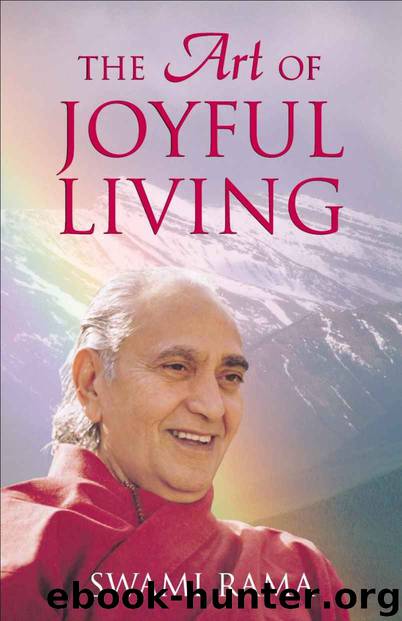The Art of Joyful Living by Swami Rama

Author:Swami Rama
Language: eng
Format: mobi, epub
Publisher: Himalayan Institute Press
Published: 2003-09-01T04:00:00+00:00
Chapter 7
DEVELOPING INTUITION AND
THE WISDOM OF BUDDHI
Intuition is the path to inner wisdom. But if you want to understand it, you must first understand the avenues through which you receive knowledge. As I have said, in human beings there are three main avenues to knowledge: through the senses, through instinct, and through intuition. When you perceive something with the senses, a process called “conceptualization” goes on inside your mind, and you form a mental concept. Then the senses continue to react and to receive and perceive information according to the concept you have already formed. You create concepts, or categories, that then organize other sensory experience. But, unfortunately, the kind of knowledge received through the senses is shallow, superficial, and incomplete.
The second source of knowledge is through your instincts. But human beings do not remain in touch with their instincts in the same way that animals do. All the activities of animals are governed by nature, but not many of the activities of human beings are. Somehow, as humans, we have lost that sensitivity to our instincts. And because we are not sensitive to nature and its subtle functions, we do not remain in touch with instinctive knowledge.
The third avenue, intuition, leads you to real knowledge, eternal knowledge. In the modern world, you have been trained to understand only external knowledge, but that aspect of knowledge is incomplete. Great poets, saints, and sages do not use the ordinary routes to knowledge through the mind and senses. For example, the great poet Tagore often said, “My knowledge is not received through the mind; it’s received through a vision.” Tagore would first see something within, and that vision would inspire him—and he would then act on that vision.
Usually, you don’t see things as they are; you see things only partially rather than in their totality. That’s why those great people, the ancient men and women of wisdom, are called “seers.” They knew and saw things as they are. They saw and understood things, and then they described them. The ancient seers did not see things bit by bit; they saw things in their totality, as they truly are.
You will not find this level of wisdom through the process of sense perception. If you see something with your senses, you don’t actually see it as it is. For example, if you merely change an object’s angle, it may look quite different, and if something looks different at different times, then the description or experience of that object is incomplete and partial. And when you describe something differently from time to time, it is difficult for others to understand your concept, and thus their conceptualization may be entirely different from yours.
Knowledge received or imparted through the senses is shallow and imperfect. That is why there is always doubt in your mind: “Am I right in doing this? Have I done this correctly?” You need external confirmation; you need evidence that you have done something accurately, because your sense perception is never totally correct and you cannot be secure in it.
Download
This site does not store any files on its server. We only index and link to content provided by other sites. Please contact the content providers to delete copyright contents if any and email us, we'll remove relevant links or contents immediately.
| Anthropology | Archaeology |
| Philosophy | Politics & Government |
| Social Sciences | Sociology |
| Women's Studies |
The remains of the day by Kazuo Ishiguro(8746)
Tools of Titans by Timothy Ferriss(8157)
Giovanni's Room by James Baldwin(7116)
The Black Swan by Nassim Nicholas Taleb(6948)
Inner Engineering: A Yogi's Guide to Joy by Sadhguru(6633)
The Way of Zen by Alan W. Watts(6452)
Asking the Right Questions: A Guide to Critical Thinking by M. Neil Browne & Stuart M. Keeley(5577)
The Power of Now: A Guide to Spiritual Enlightenment by Eckhart Tolle(5544)
The Six Wives Of Henry VIII (WOMEN IN HISTORY) by Fraser Antonia(5358)
Astrophysics for People in a Hurry by Neil DeGrasse Tyson(5095)
Housekeeping by Marilynne Robinson(4253)
12 Rules for Life by Jordan B. Peterson(4218)
The Ethical Slut by Janet W. Hardy(4147)
Double Down (Diary of a Wimpy Kid Book 11) by Jeff Kinney(4145)
Skin in the Game by Nassim Nicholas Taleb(4123)
Ikigai by Héctor García & Francesc Miralles(4044)
The Art of Happiness by The Dalai Lama(4009)
Skin in the Game: Hidden Asymmetries in Daily Life by Nassim Nicholas Taleb(3868)
Walking by Henry David Thoreau(3858)
